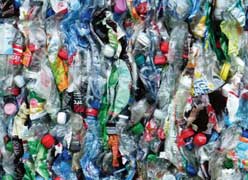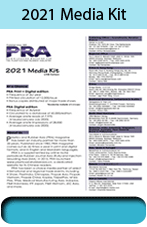Recycling: Scaling up the recyclables
New technologies and programmes are the linchpin of the global plastic value chain to expanding recycling and enhancing the quality of recyclates for product applications in order to reduce global carbon emissions, says Angelica Buan in this report.
Adversity creates opportunities, and for the plastics industry, the pressure to increase plastic recyclability or contribute to plastic waste reduction has opened up opportunities to use recycled plastic content in their products. As a result, there is a growing preference for recycled plastics over virgin plastics in a variety of new applications in the packaging, automotive, and electrical & electronics industries, as well as a slew of favourable initiatives promoting the use of recycled plastics around the world.

Even so, odour and colour issues with recycled resins persist, sometimes making it difficult to find a comparable substitute for virgin resins. As a result of these limitations, the quality of recyclates needs assurance, with the use of recycled resins overcoming technical challenges.
Europe’s timeline for recycling stepped up
Globally, the volume of plastic waste is estimated to be 300 million tonnes/year and growing, but only 9% of all plastic waste produced is recycled. The majority of waste plastic is either incinerated (12%) or disposed of in landfills (79%). The majority of plastics are made from chemicals and non-renewable resources, and by 2050 will account for 20% of total global oil consumption.
The industry is now taking a different perspective on the situation: why not use the massive amount of waste and turn it into a resource?
Recycling of plastics is an important factor in the transition to a green, circular European market, according to Plastics Recyclers Europe (PRE), a Belgium-based organisation of European plastics recyclers. Technology advancements, product design, and an enhanced system of collection and sorting, as well as optimised recycling procedures, are key to transformation, PRE said.
It’s unsurprising then that Europe, as a driving force behind the circular economy agenda, is taking more aggressive steps with trade associations backing the statute for increasing to 30% the recycled content target for plastics packaging by 2030.
Members of the Brussels-based organisation are already working toward this goal, investing billions of euros on expanded high-quality recycled plastic supplies and technology solutions, it adds.
Meanwhile, PlasticEurope said that by 2030, it plans to invest EUR7.2 billion into chemical recycling, which it says will keep plastic waste out of landfills and incinerators. Significant amounts of recycled material with virgin plastic characteristics will be produced using this process. The technology complements mechanical recycling and can help Europe achieve a climate-neutral and competitive circular economy, it adds.
Utilising data for effective recycling outcome
Meanwhile, data collection is required to track the progress of the uptake of high-quality secondary raw materials. Thus, PolyREC, a non-profit organisation formed by PlasticsEurope, PRE, Petcore Europe, a European PET value chain association; and VinylPlus, an initiative by the European PVC industry, will monitor, verify, and report the plastics recycling and uptake data in Europe, using a common data collection platform (RecoTrace).

PolyREC will ensure traceability, transparency, and trust in recycled materials along the entire plastics value chain. The partners add that PolyREC’s establishment has been critical, particularly in the context of the Circular Plastics Alliance (CPA); of meeting CPA objectives, legislative traceability mandates, and industry-wide recycling targets.
PolyREC has recently been joined by value chain initiatives like the Polyolefin Circular Economy Platform (PCEP), Styrenics Circular Solutions (SCS), and European Manufacturers of Expanded Polystyrene (EUMEPS) to leverage the benefits of data systems in the polyolefins, styrenics, and EPS segments.
Project focuses on recyclate quality for packaging use
Meanwhile, a new project funded by the EU’s Horizon 2020 research and innovation programme and coordinated by Spain-domiciled research centre ITENE has been launched. Known as Merlin, which stands for increasing the quality and rate of multi-layer packaging recycling, it is made up of a consortium of 14 European partners and is expected to recover and recycle over 3 million tonnes/year of multilayer packaging waste in Europe.
Sorting technology providers, recyclers, research centres, social innovation experts, and end-users will collaborate on recycling solutions for rigid and flexible multi-layer plastic packaging waste from post-consumer/industrial sources, with the goal of designing cradle to cradle packaging solutions for the food packaging industry
The EUR4.92-million project, which runs from 2021-2024, will implement solutions for sorting that will involve combining optical sensors, Artificial Intelligence (AI) and robotics; delamination by optimising depolymerisation and using solventbased processes; recycling, which will include repolymerisation and upcycling of polymers; and validation by developing rigid and flexible packaging solutions and demonstrating the circularity of the processes.
US accelerates recycling and recycled content uptake
In the US, increased recycled content in products is also being advocated to alleviate the load of discarded plastics and encourage recycling rates.
Led by the American Chemistry Council (ACC), the initiatives will cover such targets as participation of all US manufacturing sites operated by ACC’s Plastics Division members in Operation Clean Sweep-blue. The latter is a programme launched with the Plastics Industry Association (PLASTICS) to assist plastic resin handling operations in achieving zero resin loss by 2020; 100% of recyclable plastics packaging by 2030; and 100% of reuse/recovery of plastics packaging by 2040.
Plastic resin producers plan to focus on six key areas to achieve these objectives, namely, designing new products for greater efficiency, recycling, and reuse; developing new technologies and systems for collecting, sorting, recycling, and recovering materials. Other initiatives include facilitating participation of consumers in recycling and recovery programmes; expanding the types of plastics collected and repurposed; as well as matching the plastic collection and repurposing efforts with goals.
Similarly, the ACC unveiled a five-point plan in July to accelerate the growth of recycling to reduce plastic waste and achieve a 30% recycled plastic content in packaging by 2030. It seeks a comprehensive national policy that will involve the participation of the entire plastics value chain. Furthermore, it states that chemical and mechanical recycling will be expanded, and an “American-designed” producer responsibility system for plastic packaging will be established. That being said, a number of firms have reportedly made voluntary commitments to utilise at least 25% post-consumer resin (PCR) in their packaging by 2025.
(PRA)
Subscribe to Get the Latest Updates from PRA Please click here
©2021 Plastics and Rubber Asia. All rights reserved.

©2020 Plastics and Rubber Asia. All rights reserved.
Home Terms & Conditions Privacy Policy Webmail Site Map About Us
















